Comparative Study of the Effective Release Energy, Residual Gas Fraction, and Emission Characteristics with Various Valve Port Diameter-Bore Ratios (VPD/B) of a Four-Stroke Spark Ignition Engine
Abstract
1. Introduction
2. Experimental Setup, Material, and Methods
2.1. Experiment Setup
2.2. Applied Engine
2.3. Simulation Model Setup
3. Results and Discussion
3.1. Model Validation
3.2. Comparative Studies the Effect of Various Valve Port Diameter-Bore Ratios on Effective Release Energy and Emission Characteristics
4. Conclusions
- (1)
- A lager intake port diameter causes a decrease of volumetric efficiency, while volumetric efficiency increases with a larger exhaust port diameter.
- (2)
- The VPD/B ratio gets large influence on residual gas fraction, effective energy, and engine emission. As the increase of VPD/B ratio of 0.3 to 0.5 the residual gas fraction increases 27.3% with larger intake port and decrease 18.6% with larger exhaust port. The engine will perform optimal efficiency when the trapped residual gas fraction is from 13 to 14%. The maximum effective release energy was 0.45 kJ at 0.4 intake port-bore ratio, and 0.451 kJ at 0.35 exhaust port-bore ratio.
- (3)
- The maximum peak firing temperature and peak pressure increase was 2047 K and 0.87 bar at 0.4 intake port-bore ratio. This value was 2056 K and 0.87 bar at 0.3 exhaust port-bore ratio.
- (4)
- The optimal effective release energy and BSFC was achieved at the same VPD/B value. When the VPD/B ranges from 0.35 to 0.4, the engine performs the maximum effective release energy and the minimum BSFC. The engine does not operate well when the VPD/B ratio value is smaller than 0.35 or bigger than 0.45 because misfiring may happen.
- (5)
- This result shows that the exhaust valve port-bore ratio has a more sensitive effect on NOx emission than intake valve port-bore ratio.
- (6)
- With the intake port-bore ratio is smaller than 0.35 and exhaust valve port-bore ratio is bigger than 0.45. The high HC emission and low CO emission were presented.
Author Contributions
Funding
Conflicts of Interest
Nomenclature
| BDC | Bottom dead center |
| TDC | Top dead center |
| BTDC | Before top dead center |
| ATDC | After top dead center |
| BSFC | Brake specific fuel consumption (g/KWh) |
| BMEP | Brake mean effective pressure (Bar) |
| IMEP | Indicated mean effective pressure (Bar) |
| HC | Hydrocarbon |
| CA | Crank angle (deg) |
| VPD/B | Valve port diameter-bore ratio (-) |
| Teff | Engine effective torque (Nm) |
| Kcylce | Simulation cycle parameter (cycles) |
| Qh | The total fuel heat input (W) |
| α | The crank angle (deg) |
| α0 | The start of combustion (deg) |
| The combustion duration (deg) | |
| m | The shape parameter (-) |
| a | The Vibe parameter (-) |
| QT | The heat lost to the wall (W/m2) |
| A | The total surface area of the cylinder head, piston |
| qcoeff | The heat transfer coefficient (W/m2 K) |
| Tc | The combustion gas temperature (K) |
| Tw | The wall temperature of the cylinder (K) |
| The air mass flow rate | |
| Aeff | The effective flow area (-) |
| P1 | The upstream stagnation pressure (Pa) |
| T1 | Upstream stagnation temperature (K) |
| R | Gas constant (J/kg.K) |
| P2 | Downstream static pressure (Pa) |
| K | Ratio of specific heat |
| Cp | Denotes post processing multiplier |
| CK | Denotes kinetic multiplier |
| ri | Demotes reaction rates (mole/cm3s) |
| mHC | Mass of unburned charge in the crevices (kg) |
| Pc | Cylinder pressure (Pa) |
| Vcrevice | Total crevice volume (m3) |
| M | Unburned molecular weight (kg/kmol) |
| Tpiston | Piston temperature (K) |
| θ | Cam angle (deg) |
| Cd | Coefficient of discharge |
| Q | Measured volume flow rate (m3/sec) |
| Aseat | Inner seat area (m2) |
| Av | Orifice are between valve head and seat (m2) |
| EGR | Exhaust gas recirculation |
| VD | Displaced volume (m3) |
| Cf | Flow coefficient |
| V0 | Velocity dead (m/s) |
| Dseat | Intake valve seat diameter (m) |
| L | Valve lift (m) |
| φ | Valve seat angle (deg) |
| n | Engine speed (rpm) |
References
- Cinar, C.; Uyumaz, A.; Solmaz, H.; Topgul, T. Effects of valve lift on the combustion and emis-sions of a HCCI gasoline engine. Energy Convers. Manag. 2015, 94, 159–168. [Google Scholar] [CrossRef]
- Suhaimi, S.; Mamat1, R.; Abdullah, N.R. Investigation of the effects of inlet system configuration on the airflow characteristics. IOP Conf. Ser. Mater. Sci. Eng. 2013, 50. [Google Scholar] [CrossRef]
- Shi, L.; Shu, G.; Tian, H.; Deng, S. A review of modified Organic Rankine cycles (ORCs) for internal combustion engine waste heat recovery (ICE-WHR). Renew. Sustain. Energy Rev. 2018, 92, 95–110. [Google Scholar] [CrossRef]
- Jung, D.; Iida, N. An investigation of multiple spark discharge using multi-coil ignition system for improving thermal efficiency of lean SI engine operation. Appl. Energy 2018, 212, 322–332. [Google Scholar] [CrossRef]
- Gandyk, M.; Tkaczyk, M.; Sitnik, L.J.; Uzuntonev, T. Combustion engine intake port design analysis. Mach. Technol. Mater. 2015, 9, 29–31. [Google Scholar]
- Regueiro, J.F.; Korn, S.J. Geometric papameters of four-valve cylinder heads and their relationship to combustion and engine full load performance. SAE Trans. 1994, 103, 184–198. [Google Scholar]
- Zhang, Y.; Zhao, H.; Xie, H.; He, B.-Q. Variable-valve-actuation enabled high efficiency gasoline engine. J. Auto-Mobile Eng. 2010, 224, 1081–1095. [Google Scholar] [CrossRef]
- Ghazal, O.H.; Najjar, Y.S.; AL-Khishali, K.J. Effect of Varying Inlet Valve Throat Diameter at Different IVO, IVC, and OVERLAP Angles on SI Engine Performance. In Proceedings of the World Congress on Engineering 2011 (WCE 2011), London, UK, 6–8 July 2011. [Google Scholar]
- Raghu, M.M.; Pramod, S. Influence of intake port design on diesel engine air motion characteristics. Indian J. Eng. Mater. Sci. 1999, 6, 53–58. [Google Scholar]
- Yasar, A.; Sahin, B.; Akilli, H.; Aydin, K. Effect of inlet port on the flow in the cylinder of an internal combustion engine. Proc. Inst. Mech. Eng. Part C J. Mech. Eng. 2006, 220, 72–83. [Google Scholar]
- Qi, Y.L.; Dong, L.C.; Liu, H.; Puzinauskas, P.V.; Midkiff, K.C. Optimization of intake port design for SI engine. Int. J. Automot. Technol. 2012, 13, 861–872. [Google Scholar] [CrossRef]
- Latheesh, V.M.; Parthasarathy, P.; Baskaran, V.; Karthikeyan, S. Design and CFD analysis of intake port and exhaust port for a 4 valve cylinder head engine. IOP Conf. Ser. Mater. Sci. Eng. 2018, 310. [Google Scholar] [CrossRef]
- Khoa, N.X.; Lim, O. The effects of combustion duration on residual gas, effective release energy, engine power and engine emissions characteristics of the motorcycle engine. Appl. Energy 2019, 248, 54–63. [Google Scholar] [CrossRef]
- Khoa, N.X.; Lim, O. Effective release energy, residual gas, and engine emission characteristics of a V-twin engine with various exhaust valve closing timings. J. Mech. Eng. 2020, 34, 477–488. [Google Scholar] [CrossRef]
- Petranović, Z.; Sjerić, M.; Taritaš, I.; Vujanović, M.; Kozarac, D. Study of advanced en-gine operating strategies on a turbocharged diesel engine by using coupled numerical approaches. Energy Convers. Manag. 2018, 171, 1–11. [Google Scholar]
- Teo, A.E.; Chiong, M.S.; Yang, M.; Romagnoli, A.; Martinez-Botas, R.F.; Rajoo, S. Performance evaluation of low-pressure turbine, turbo-compounding and air-Brayton cycle as engine waste heat recovery method. J. Energy 2019, 166, 895–907. [Google Scholar] [CrossRef]
- Rubio, J.A.P.; V-García, F.; Grau, J.H.; Cámara, J.M.; Hernandez, D.A. Marine diesel engine failure simulator based on thermodynamic model. Appl. Therm. Eng. 2018, 144, 982–995. [Google Scholar] [CrossRef]
- Melaika, M.; Rimkus, A.; Vipartas, T. Air Restrictor and Turbocharger Influence for the Formula Student Engine Performance. Procedia Eng. 2017, 187, 402–407. [Google Scholar] [CrossRef]
- Praptijanto, A.; Muharam, A.; Nur, A.; Putrasari, Y. Effect of ethanol percentage for diesel engine performance using virtual engine simulation tool. Energy Procedia 2015, 68, 345–354. [Google Scholar] [CrossRef]
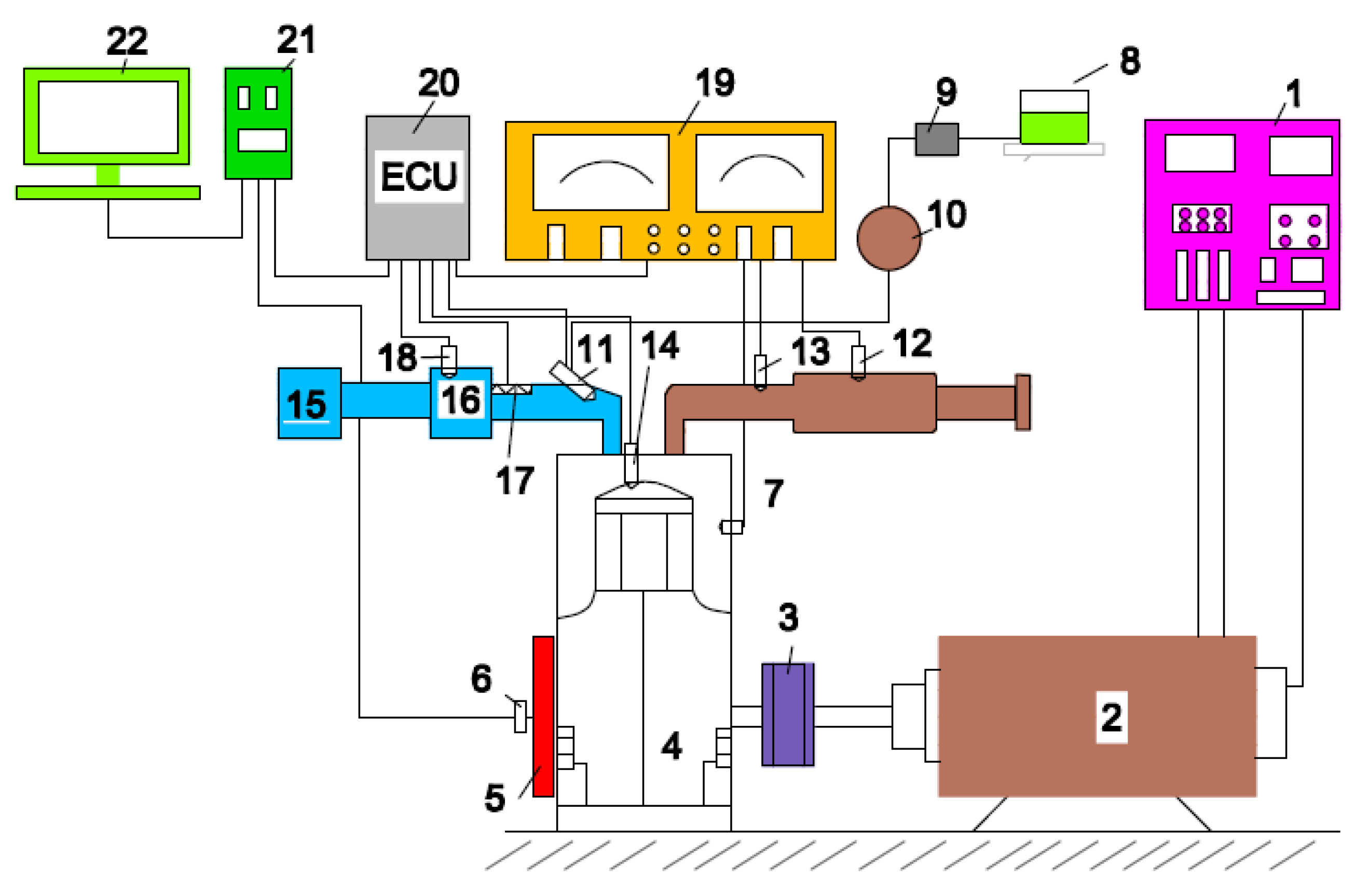
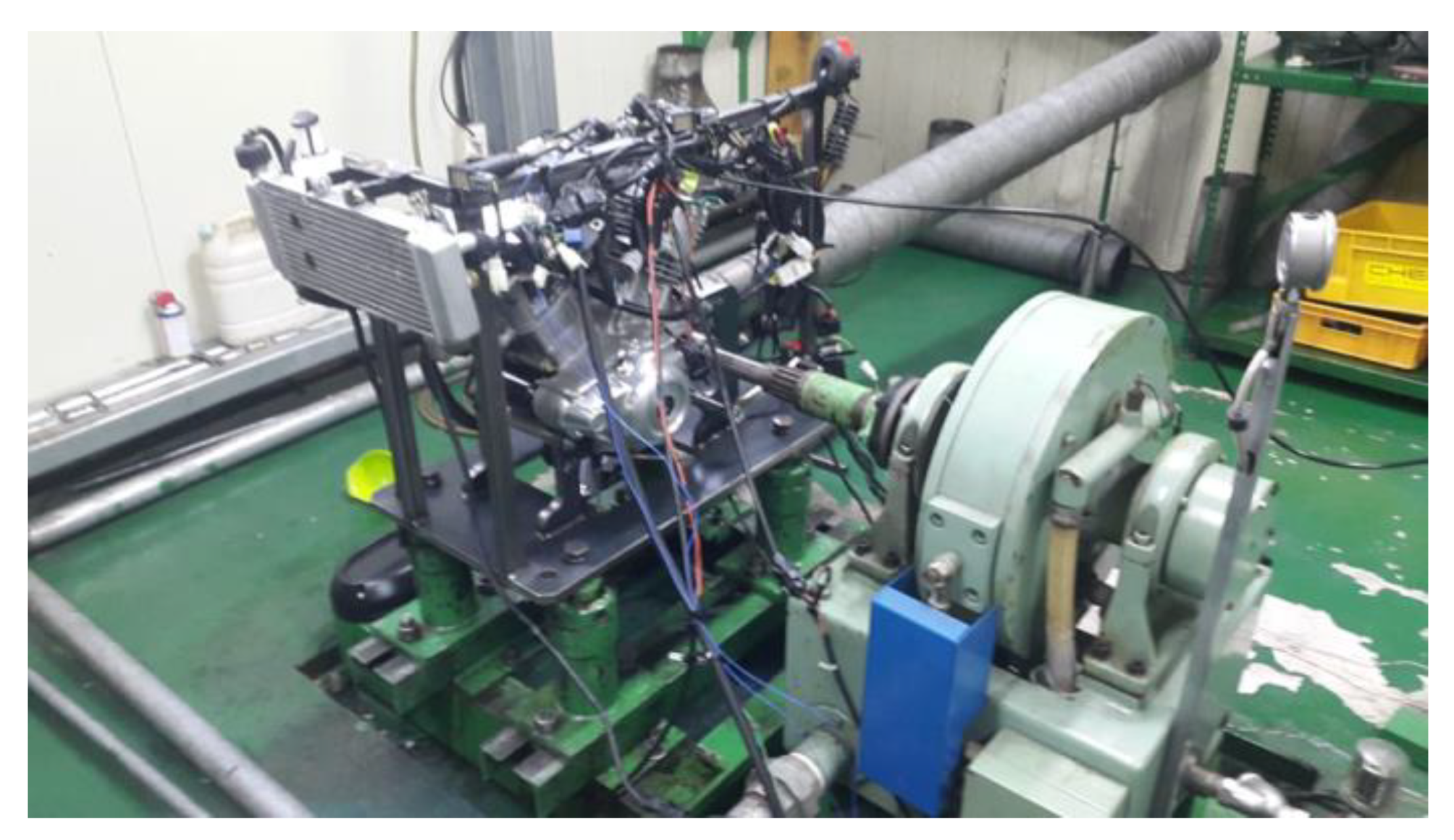
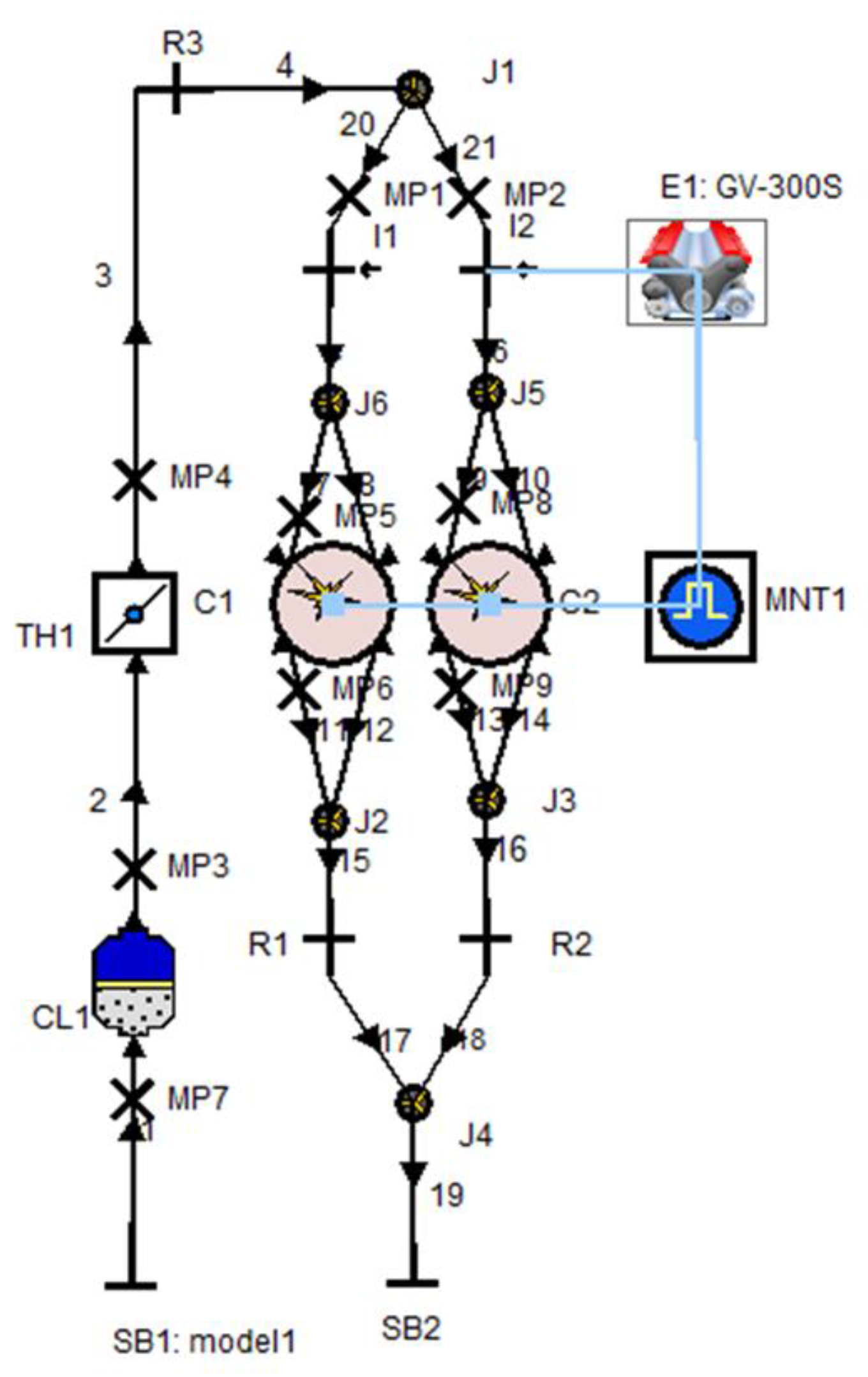
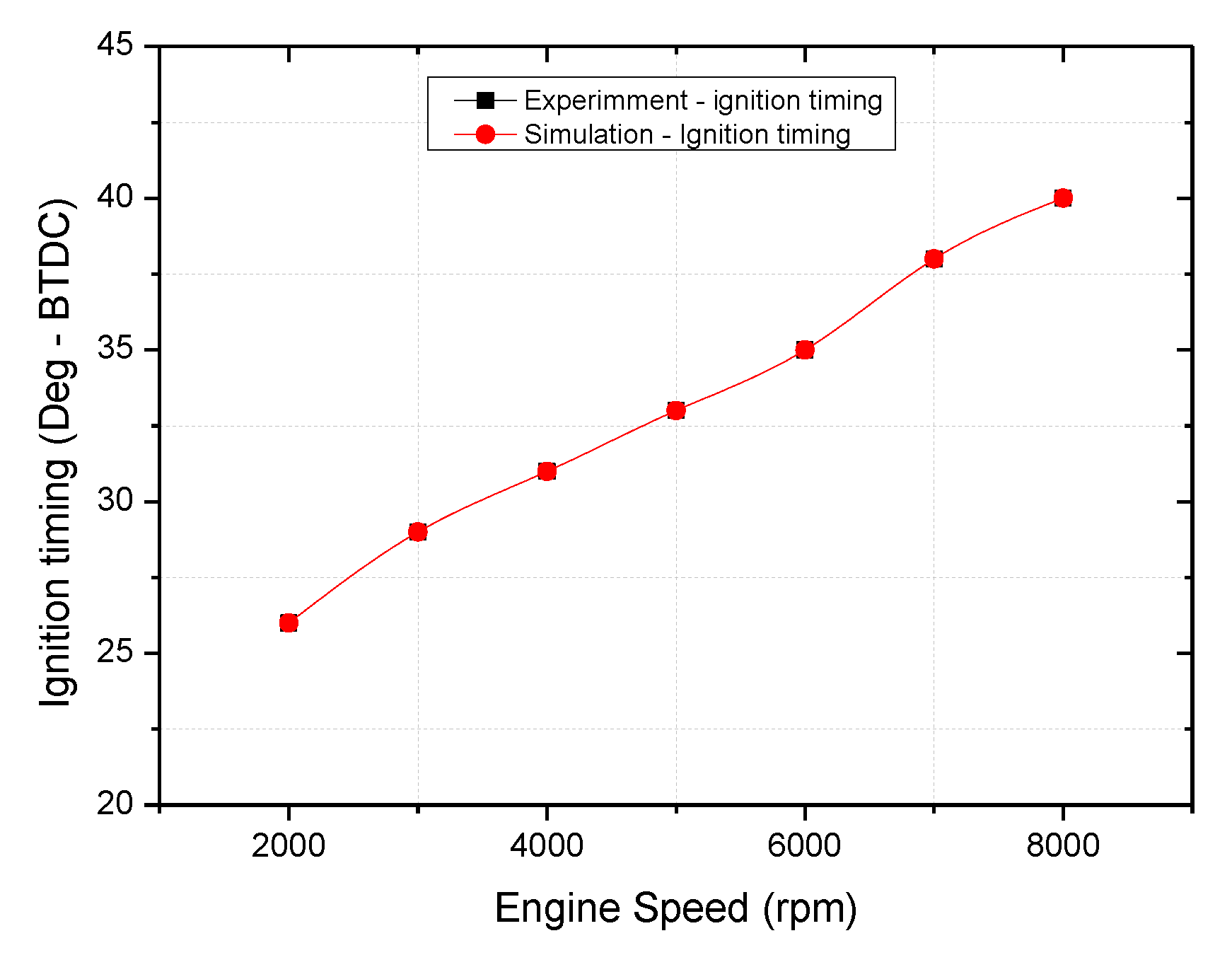
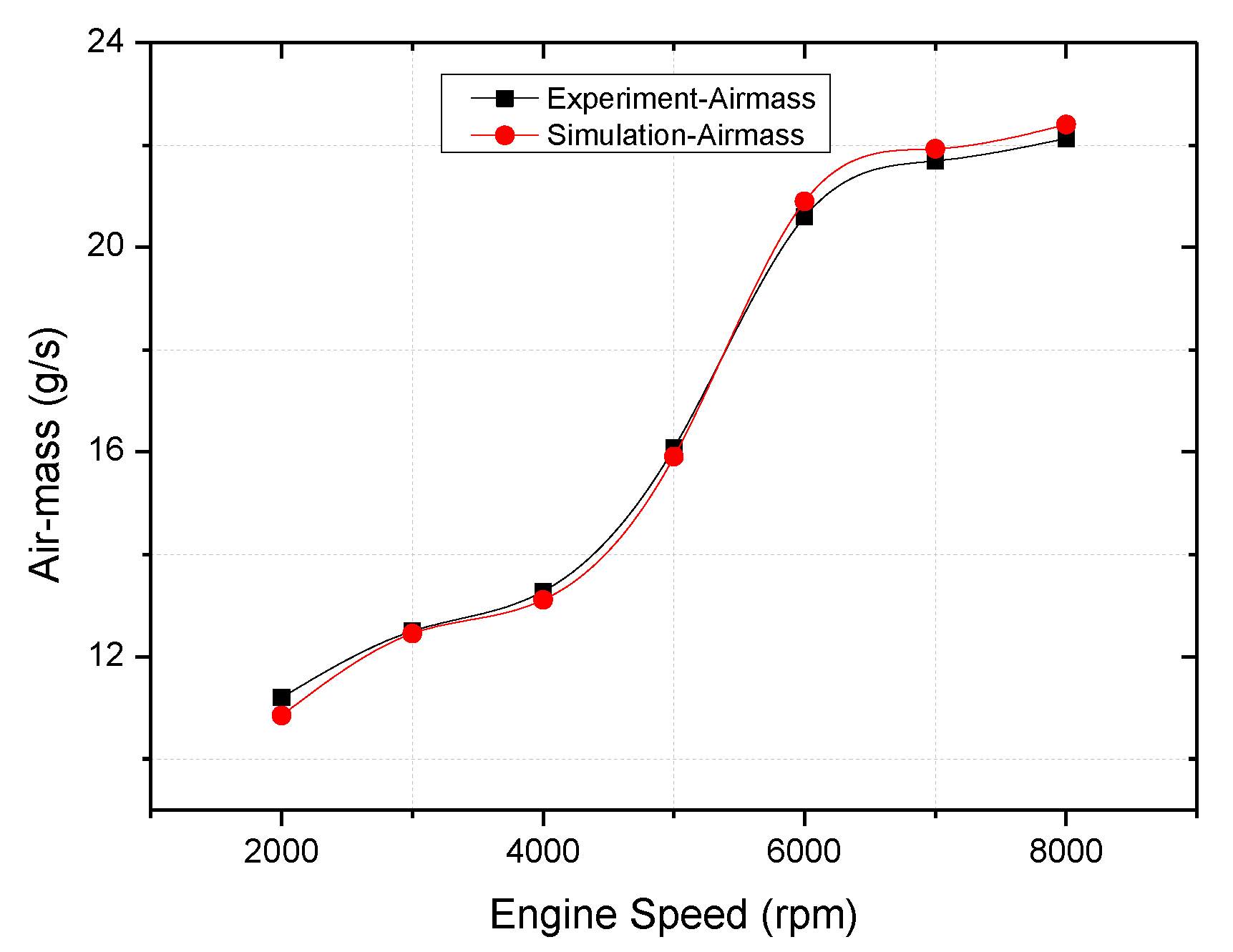
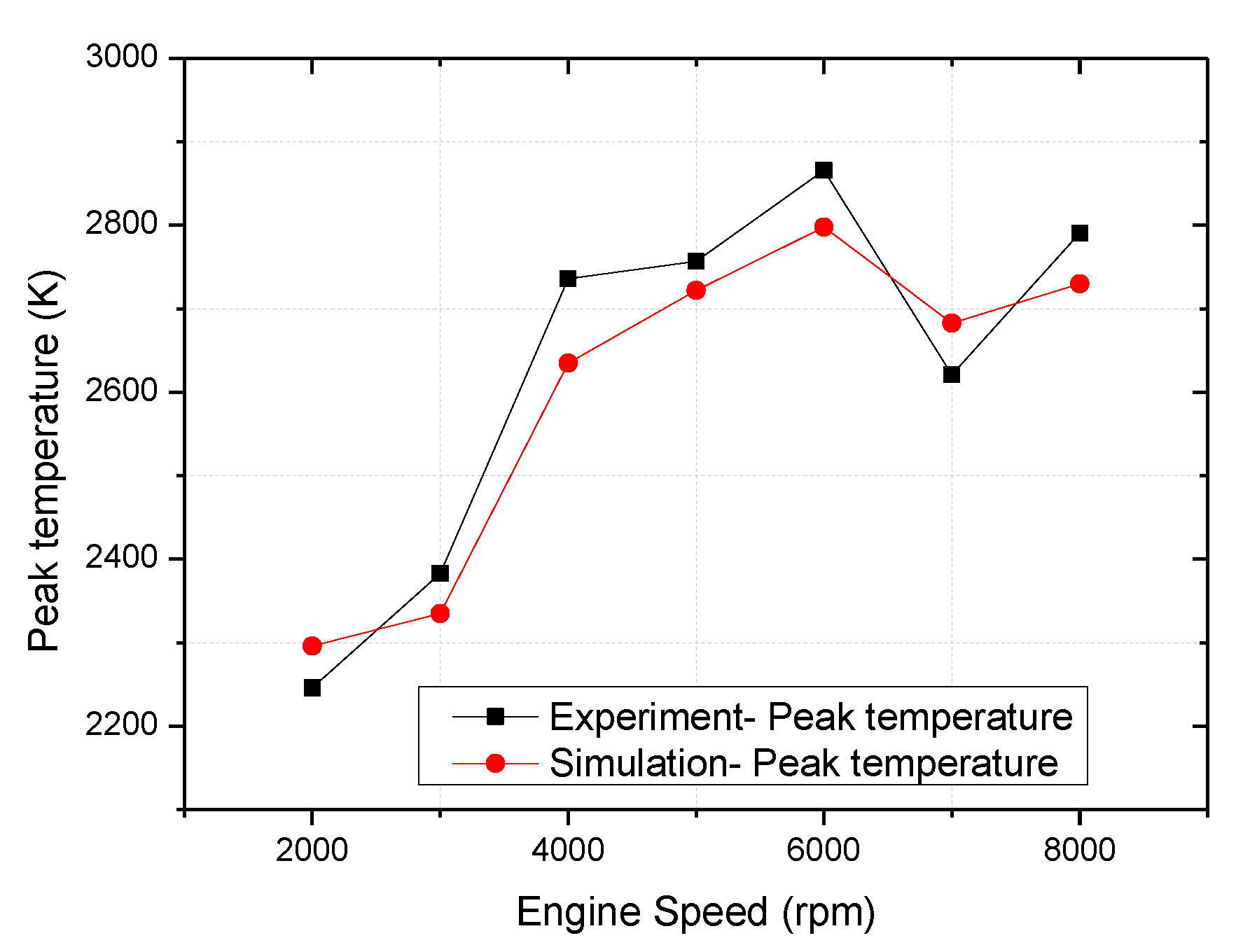
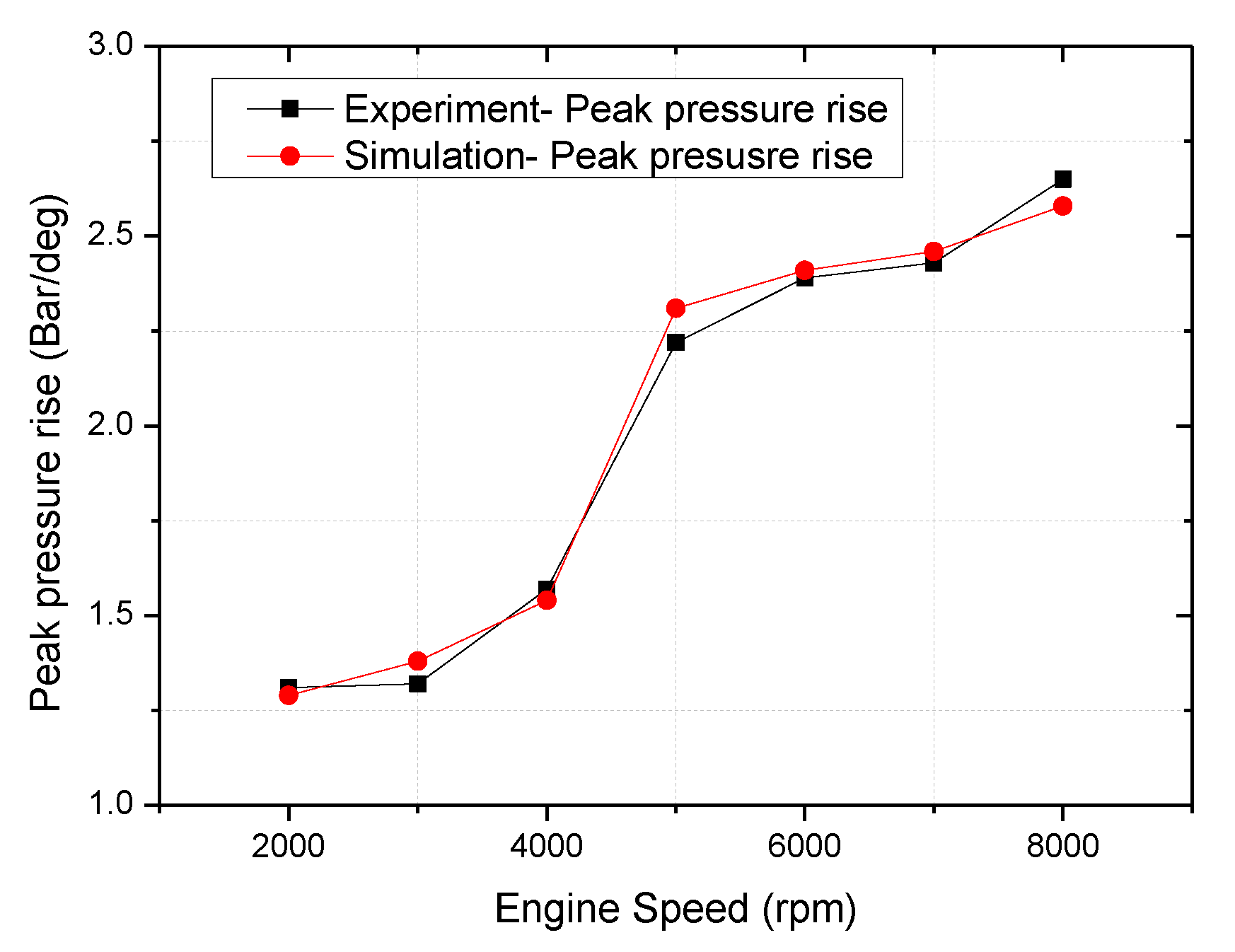
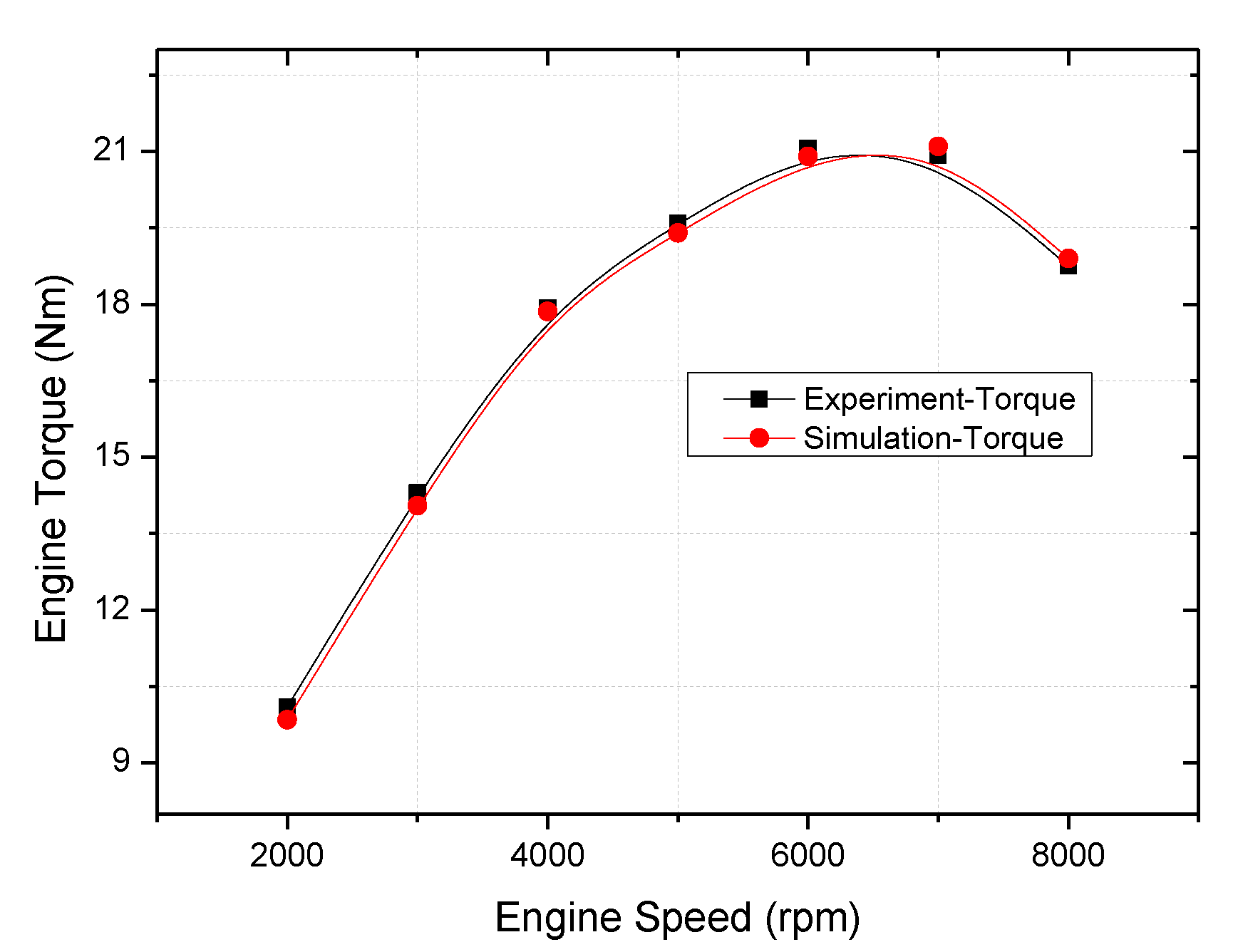
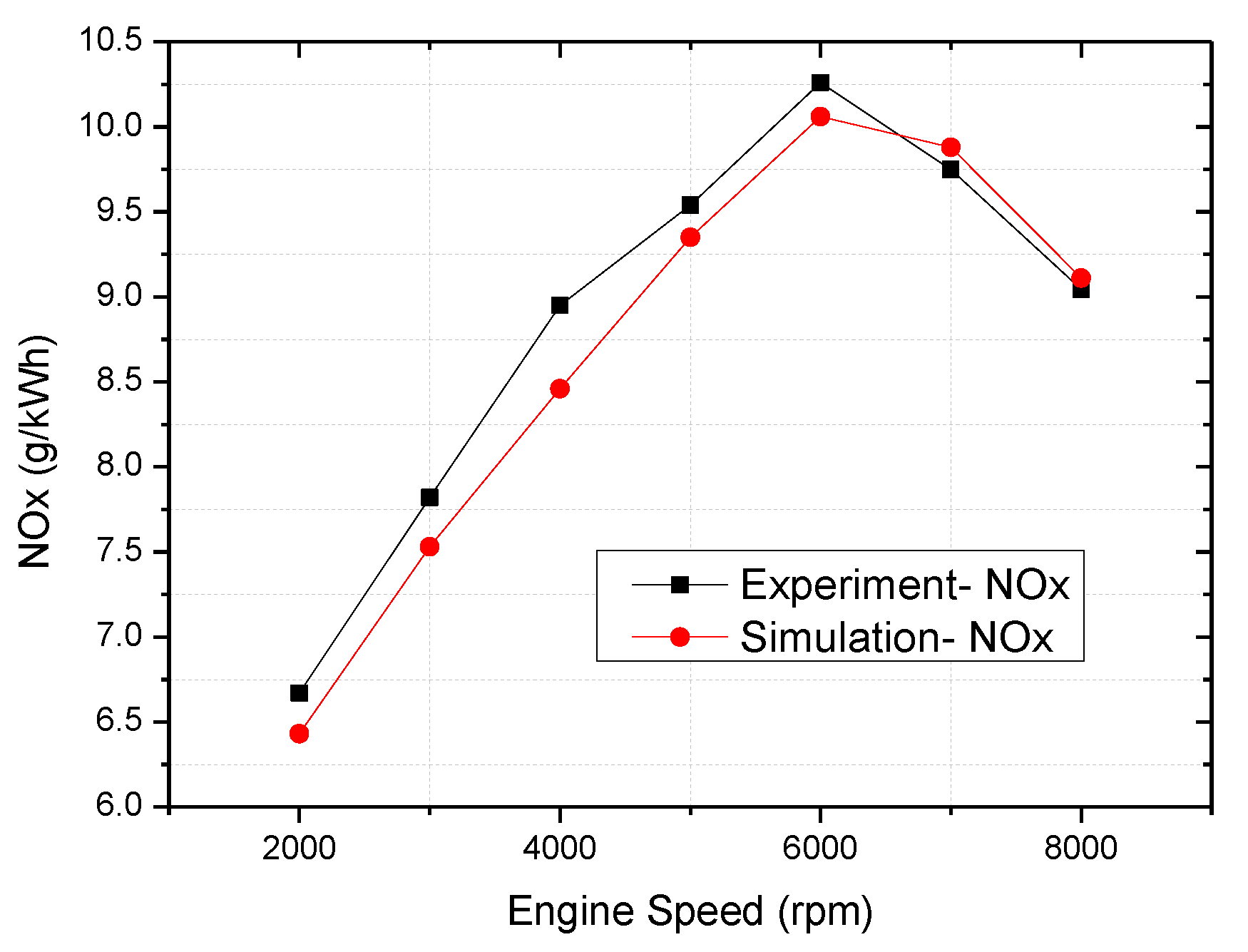
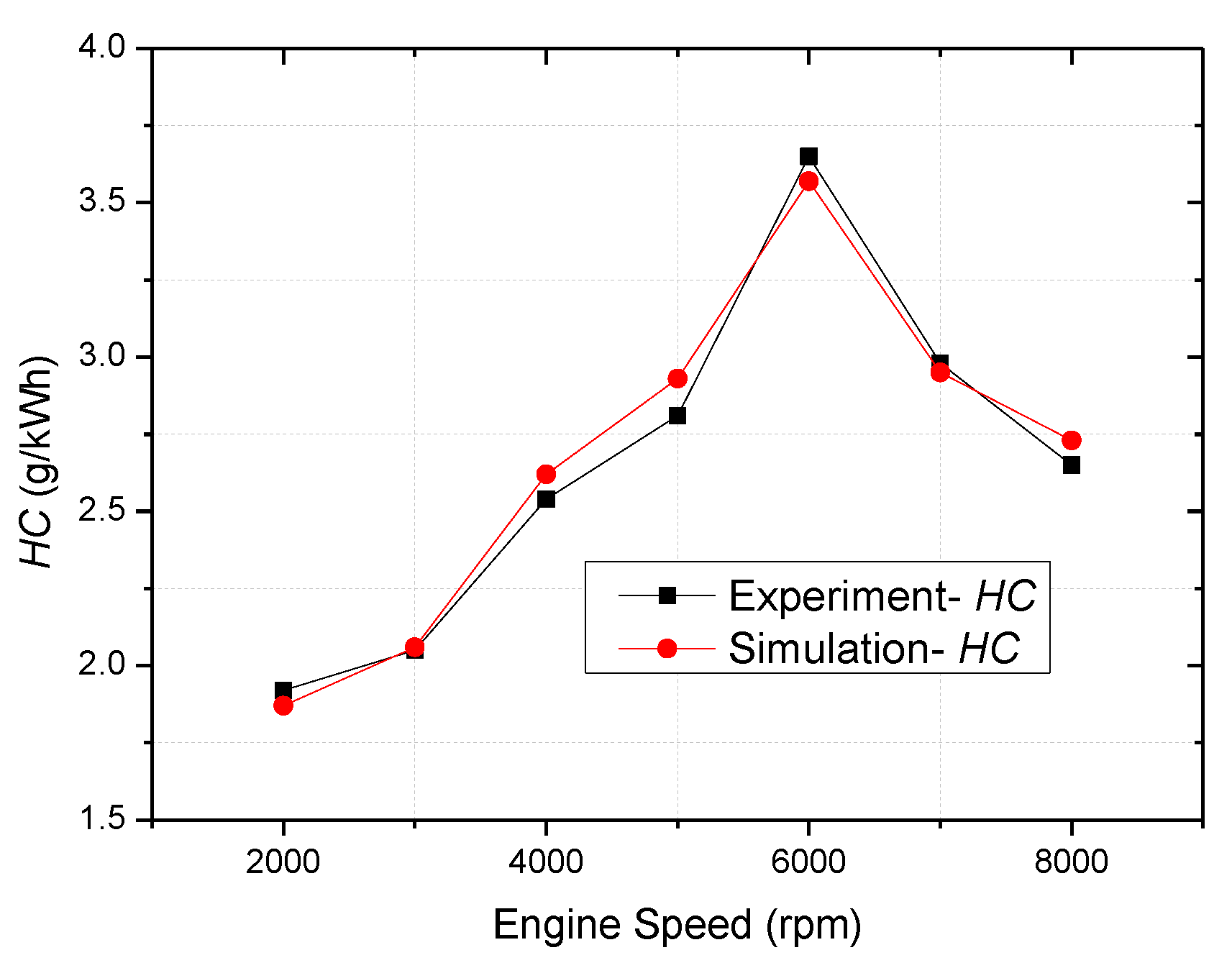
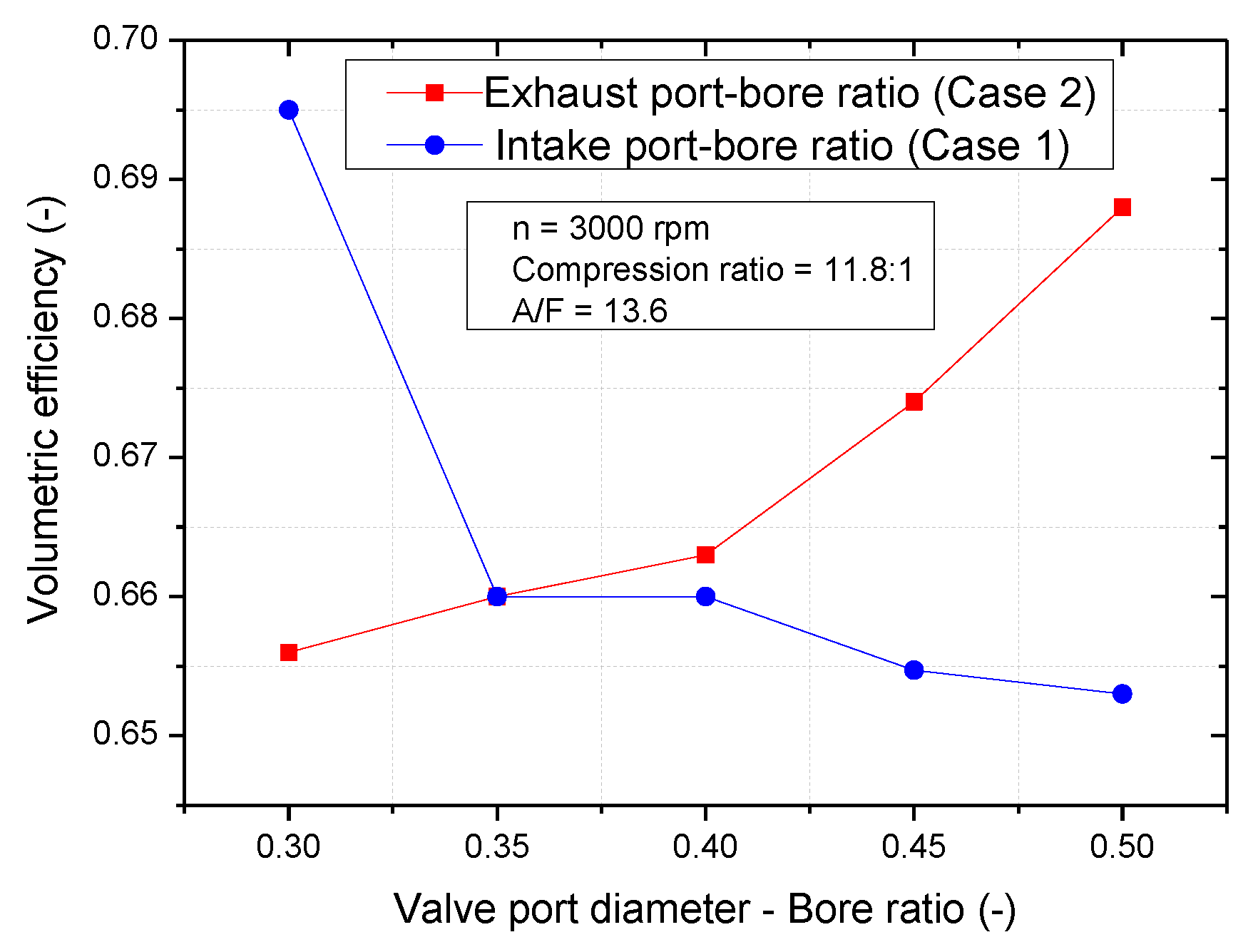
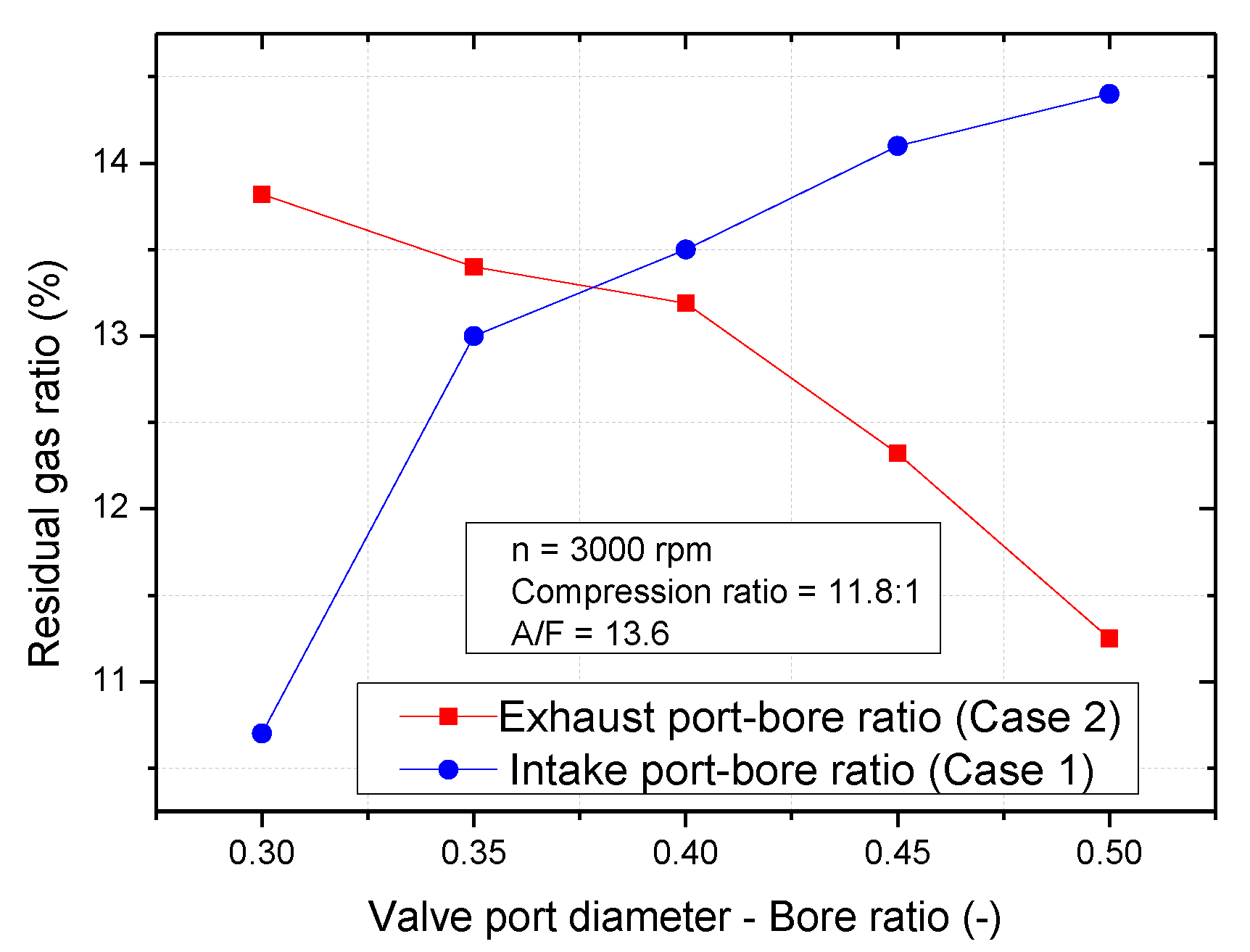
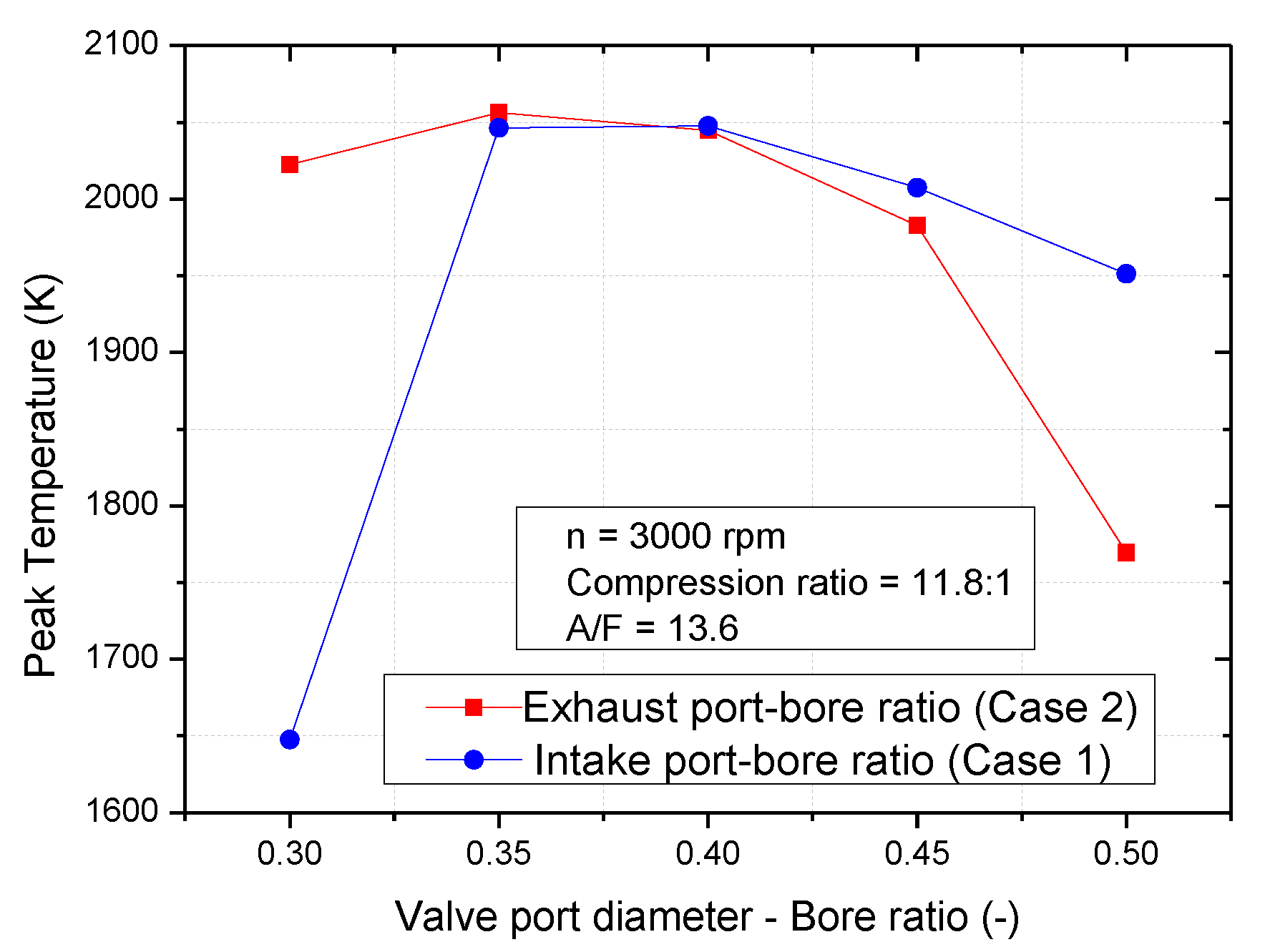
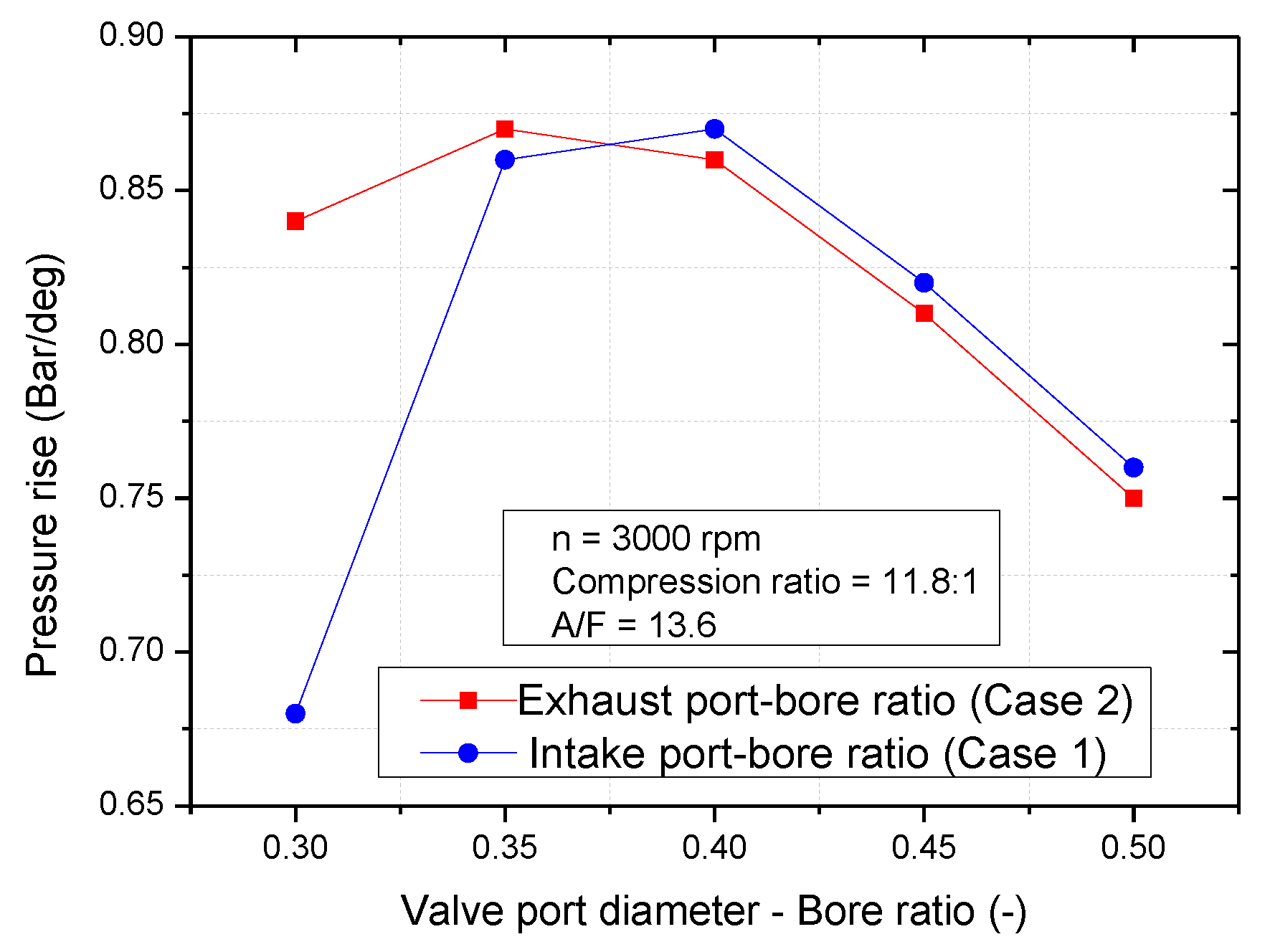

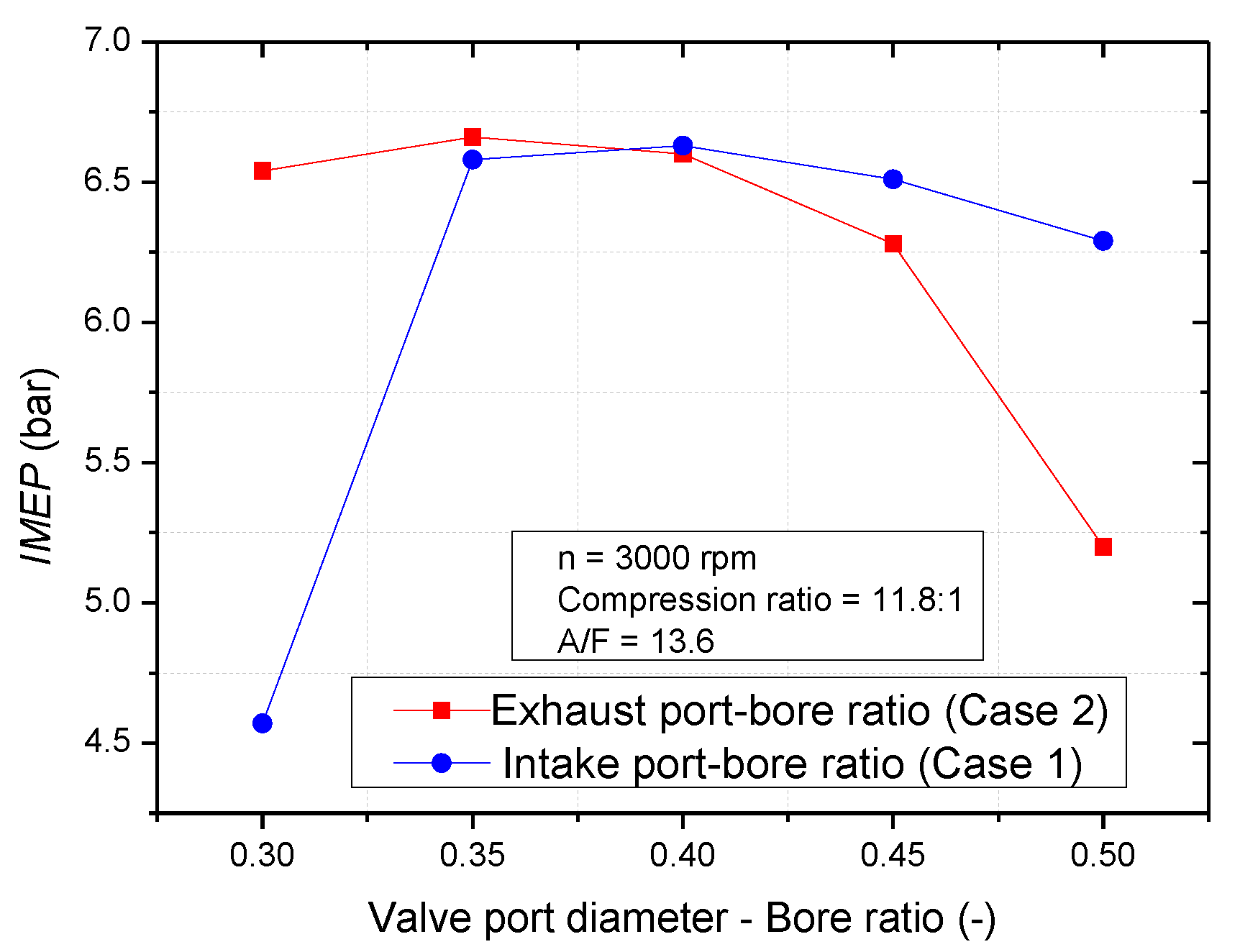
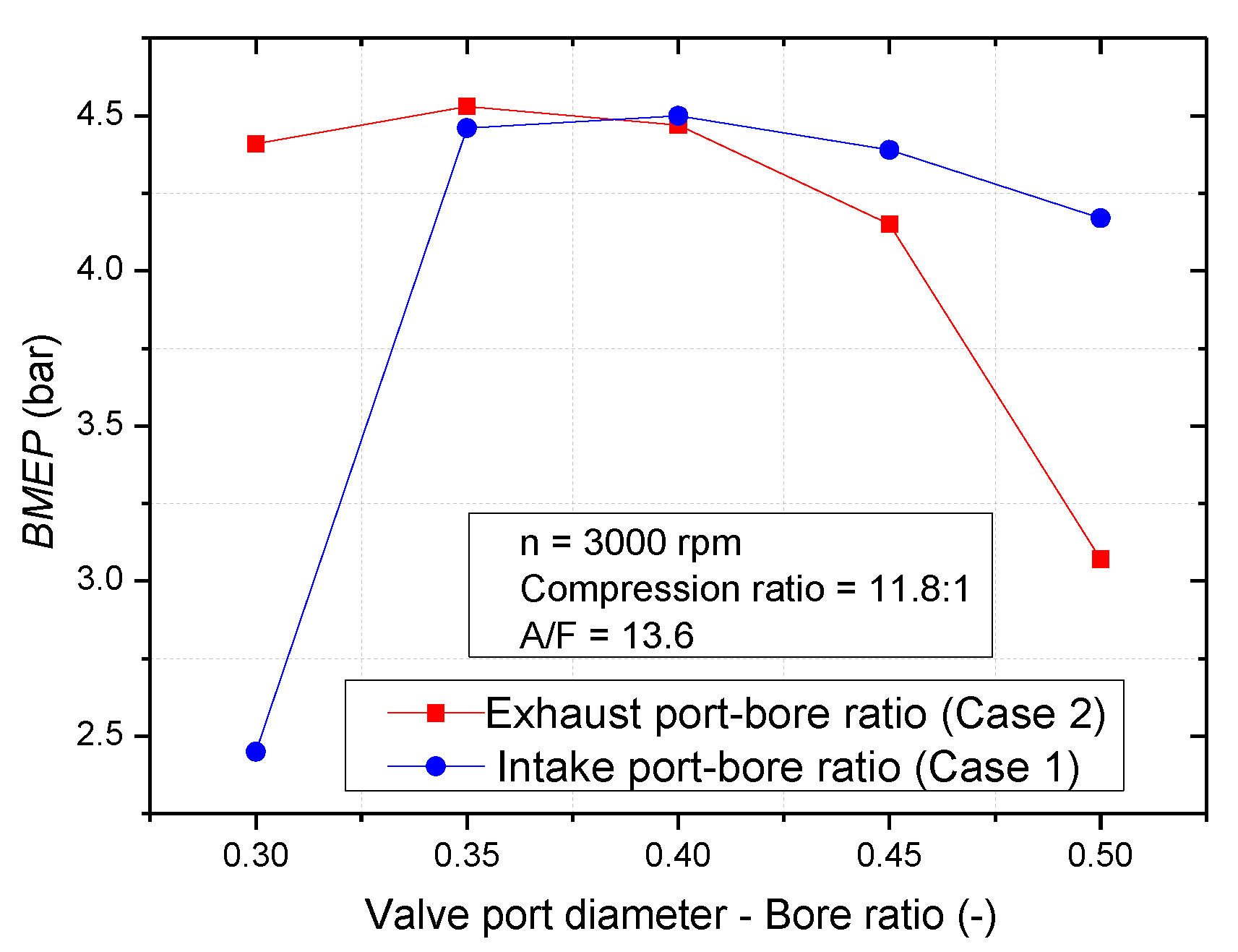
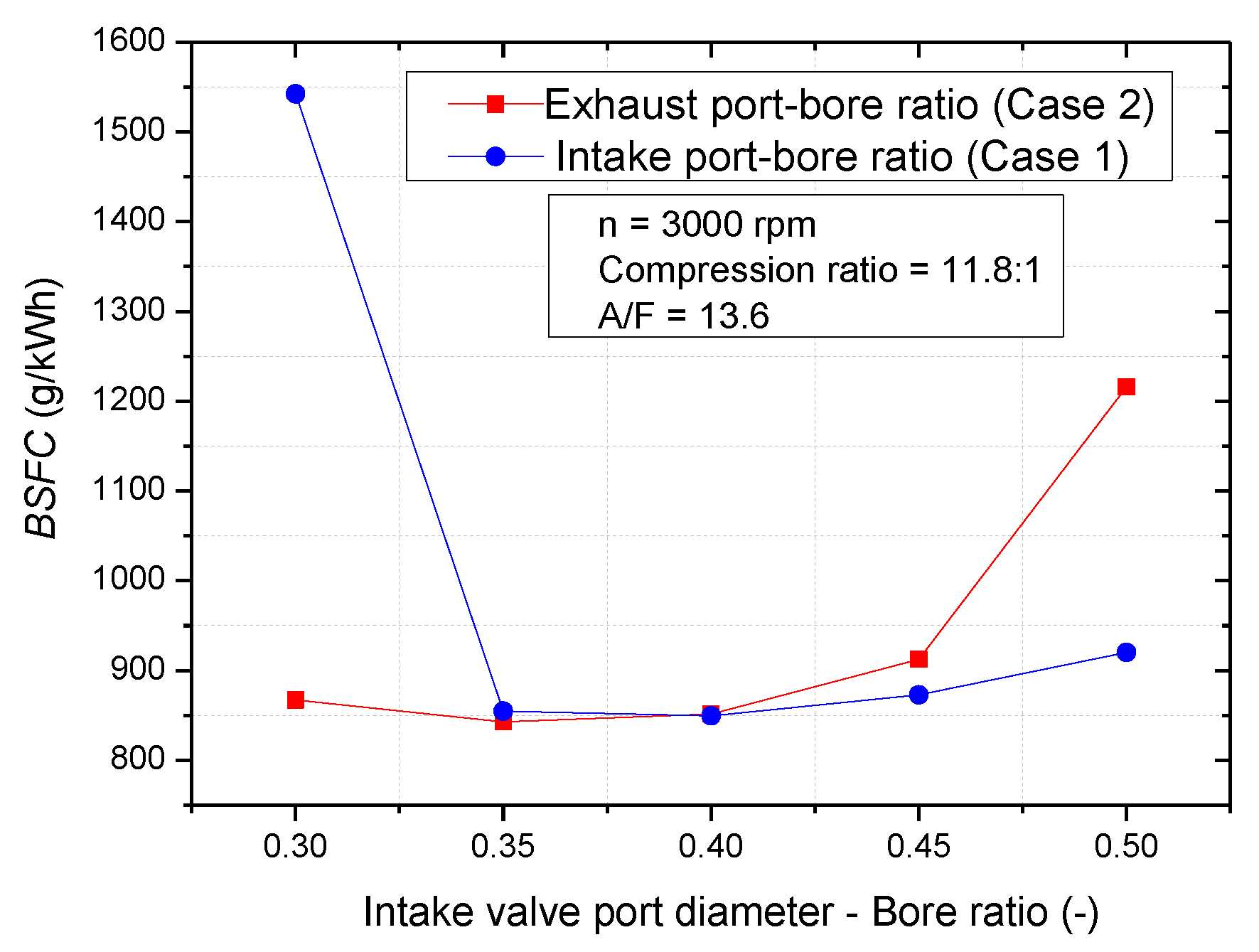
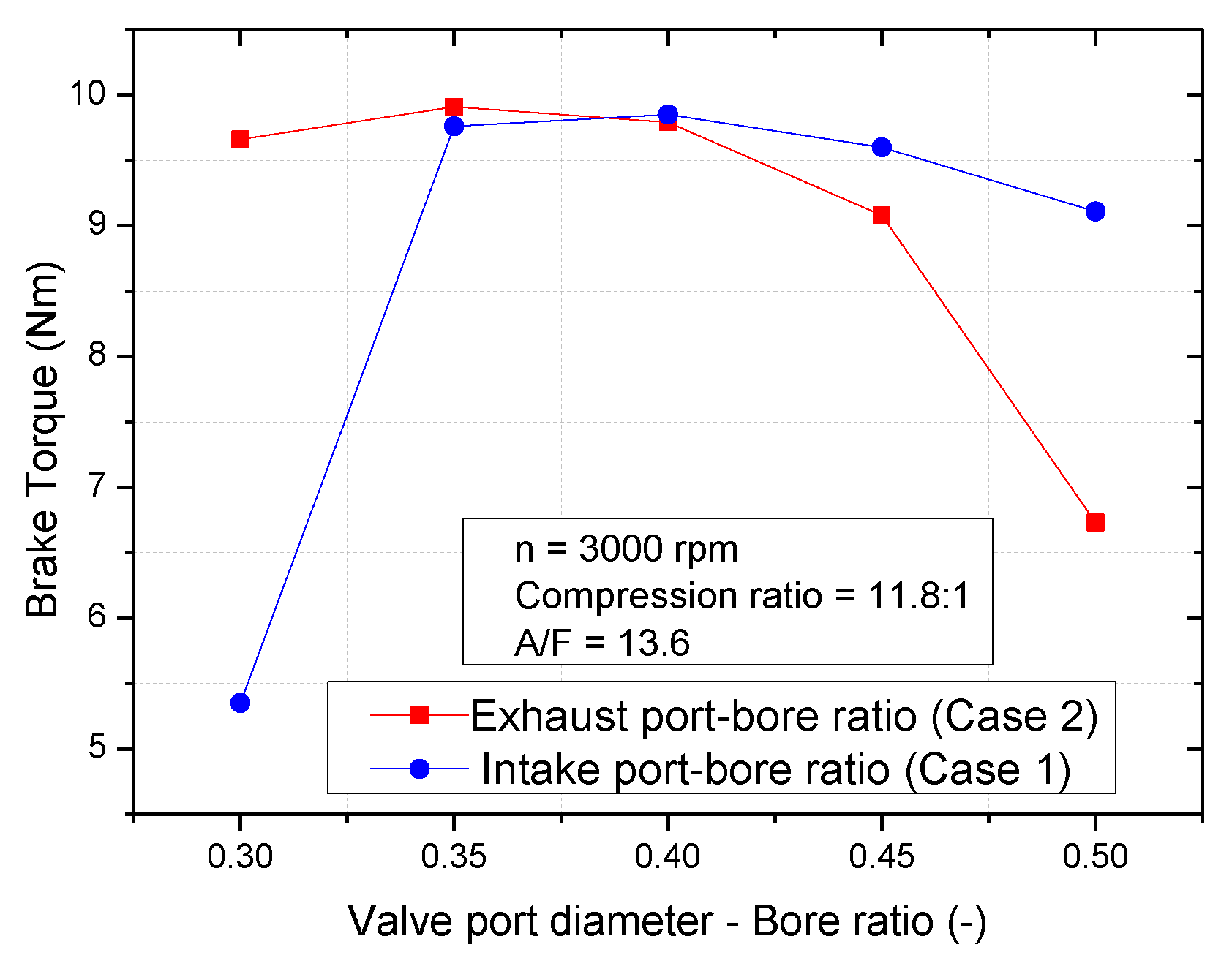
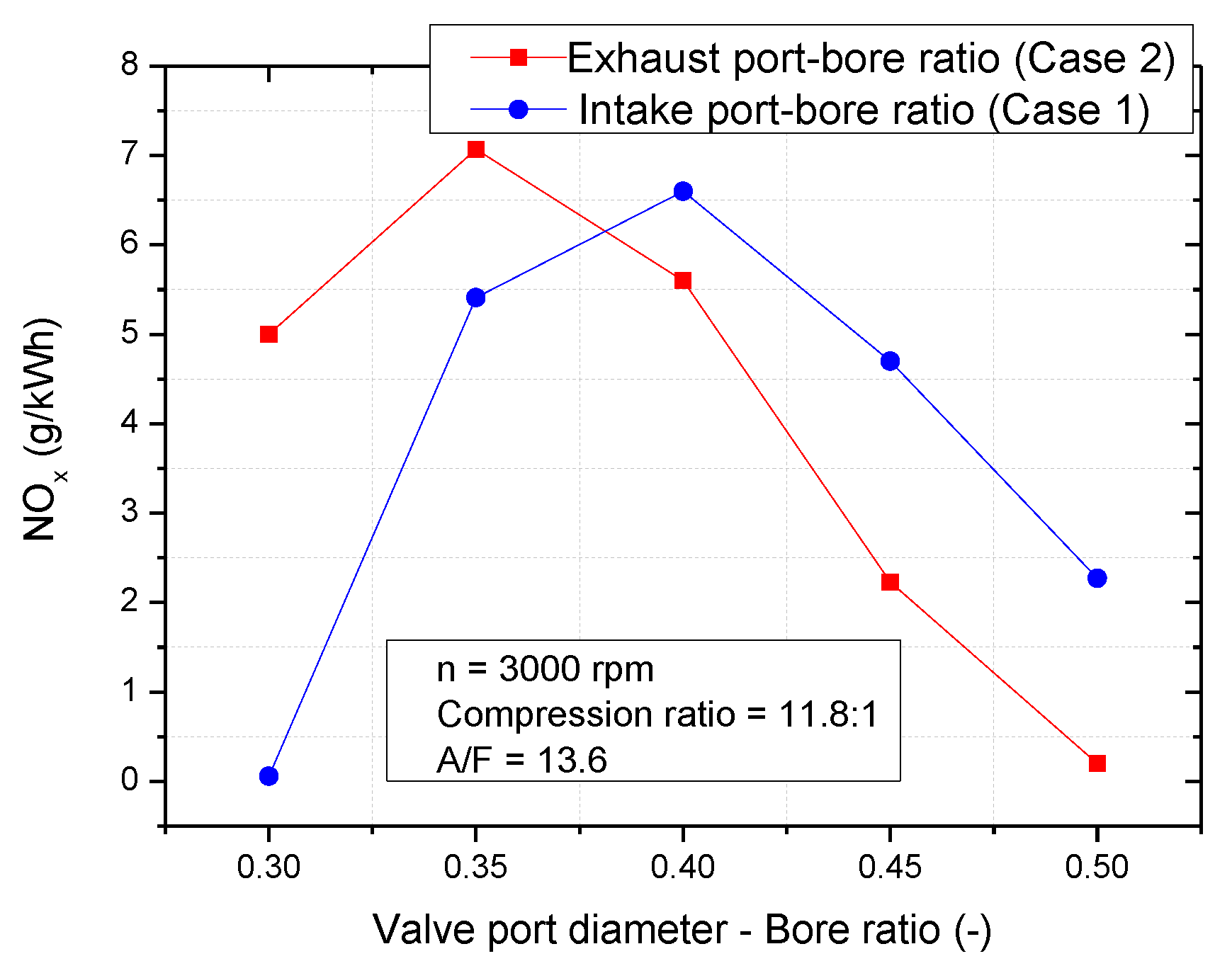
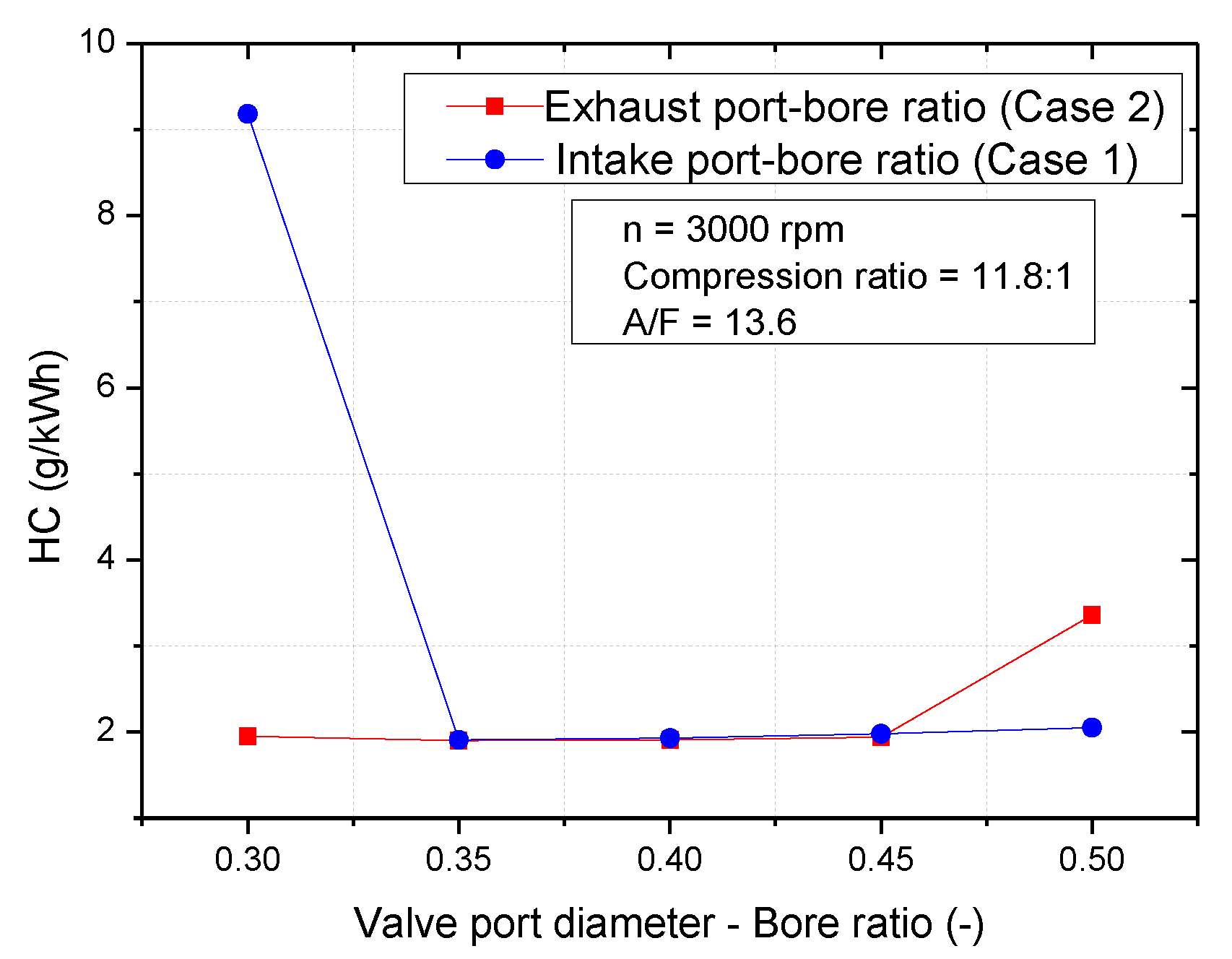
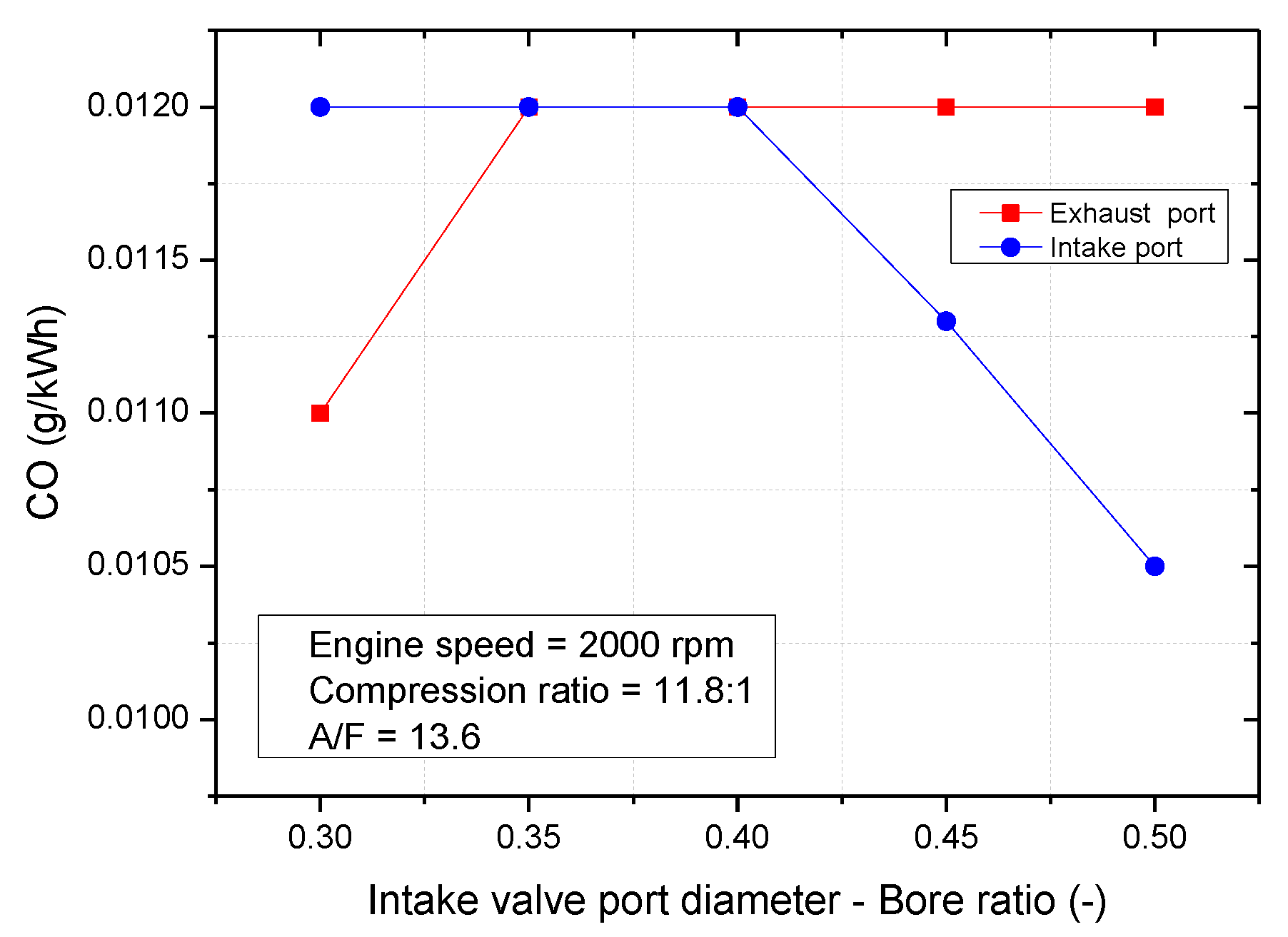
| Parameter | Unit | Value |
|---|---|---|
| Model | - | Four stroke, Spark ignition |
| Number of cylinder | - | 2 |
| Compression ratio | - | 11.8:1 |
| Bore | mm | 57 |
| Stroke | mm | 53.8 |
| Connecting rod | mm | 107.9 |
| Intake valve | - | Number: 2 valvesDiameter: 22 mm, valve lift: 6.5 mm; opening: 40 deg BTDC, closing: 200 deg ATDC. |
| Exhaust valve | - | Number: 2 valves Diameter: 22 mm, valve lift: 6.5 mm; opening time: 230 deg ATDC, closing: 30 deg ATDC. |
| Cooling system | - | Air cooled |
| VPD/B ratio | 0.3 | 0.35 | 0.4 | 0.45 | 0.5 |
| Intake and exhaust port diameter (mm) | 17.1 | 20 | 22 | 25.7 | 28.5 |
© 2020 by the authors. Licensee MDPI, Basel, Switzerland. This article is an open access article distributed under the terms and conditions of the Creative Commons Attribution (CC BY) license (http://creativecommons.org/licenses/by/4.0/).
Share and Cite
Khoa, N.X.; Lim, O. Comparative Study of the Effective Release Energy, Residual Gas Fraction, and Emission Characteristics with Various Valve Port Diameter-Bore Ratios (VPD/B) of a Four-Stroke Spark Ignition Engine. Energies 2020, 13, 1330. https://doi.org/10.3390/en13061330
Khoa NX, Lim O. Comparative Study of the Effective Release Energy, Residual Gas Fraction, and Emission Characteristics with Various Valve Port Diameter-Bore Ratios (VPD/B) of a Four-Stroke Spark Ignition Engine. Energies. 2020; 13(6):1330. https://doi.org/10.3390/en13061330
Chicago/Turabian StyleKhoa, Nguyen Xuan, and Ocktaeck Lim. 2020. "Comparative Study of the Effective Release Energy, Residual Gas Fraction, and Emission Characteristics with Various Valve Port Diameter-Bore Ratios (VPD/B) of a Four-Stroke Spark Ignition Engine" Energies 13, no. 6: 1330. https://doi.org/10.3390/en13061330
APA StyleKhoa, N. X., & Lim, O. (2020). Comparative Study of the Effective Release Energy, Residual Gas Fraction, and Emission Characteristics with Various Valve Port Diameter-Bore Ratios (VPD/B) of a Four-Stroke Spark Ignition Engine. Energies, 13(6), 1330. https://doi.org/10.3390/en13061330





